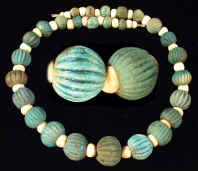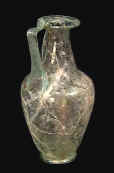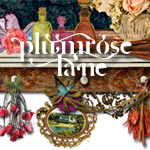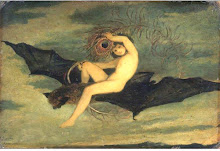
As with most things which hold my fascination, glass has ancient roots.
Colored glass beads dating to around 3500 BC have been discovered in Egypt and Mesopotamia; not the oldest types of beads, but certainly an artistic step in the evolution of this form of ornamentation. Glass glaze on ceramics was introduced to the Mediterranean in the third millennium by Phoenician merchants.
Hollow glass making was developing in the 16th century BC in Egypt, Mesopotamia, Greece and China. Fragments of glass vases were found in Mesopotamia, and vases decorated with the name of Pharaoh Thoutmosis III can be dated to 1504-1450 BC.
Not until the 9th century BC did glassmaking really spread further, when the center became Alexandria. From here did it most likely spread to Italy.
Not until the 9th century BC did glassmaking really spread further, when the center became Alexandria. From here did it most likely spread to Italy.
Finally, sometime between 27 BC and AD 14, glassblowing was discovered. Today, artists use relatively the same techniques and tools. In the last century BC, Romans began blowing glass inside moulds, which allowed for a greater variety of shapes. It was the great influence of Rome which really allowed for the glass industry to spread abroad.
Let me stop here, though, and focus on ancient Roman glass. There are a great number of artefacts existing in various states of intactness. Even the shards are so beautiful that they are prize finds in archaeological digs and make their way into fascinating jewelry art (yes, I have a few pieces in my collection!).


Let me stop here, though, and focus on ancient Roman glass. There are a great number of artefacts existing in various states of intactness. Even the shards are so beautiful that they are prize finds in archaeological digs and make their way into fascinating jewelry art (yes, I have a few pieces in my collection!).

Relying on my favorite accessible antiquities website, Ancient Touch, to tempt and taunt me with objects of ages past, I offer these images for you to admire and ponder. The iridescent patinas and graceful shapes are captivating, and I imagine holding an amphora up to the light and letting it spin out tales of another world. They have survived thousands of years and bear the memory of water and wine, and the imprint of many hands and mouths.
These phenomenal artists work with color and form like divinities stirring up time and space. The ancestors of their craft would stand in awe of their creations and declare them god-touched.
These are just some of the things that influence me when I work with my small and humble bits of glass. I imagine through the past and admire the contemporary, and it inspires me to make an offering.






















4 comments:
I used to love to look at the ancient glas in the museum. Great post, as always. And your focal piece is wonderful!
What a fabulous post...so much to learn. We often take glass for granted and yet it has such a rich history. I love your focal piece...it's beautiful!!!
Dammit!! You reminded me of that fabulous website. Hey what's this 31 days of Halloween thing?
One of these days, i will buy *something* from the Ancient Touch website...so mote it be!
The 31 Days of Halloween is an amazing giveaway that Mrs B's Confessions sponsors. Her domestic pagan website is awesome, and she get tons of people to donate stuff for the giveaway. Tune in for more!
Post a Comment